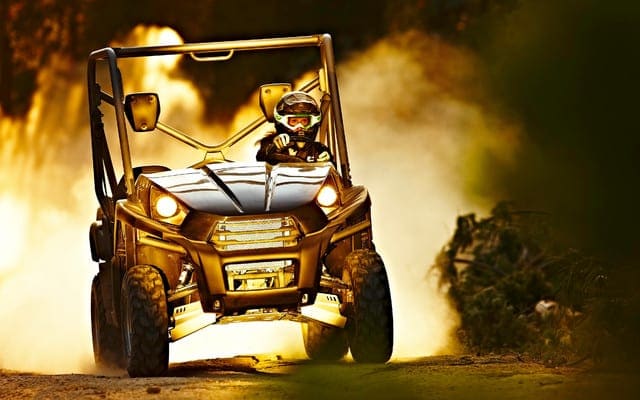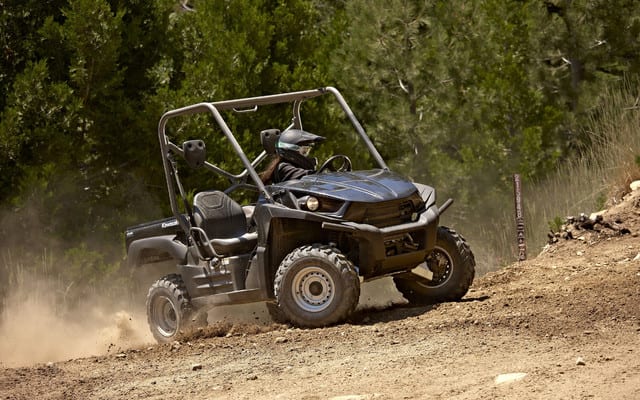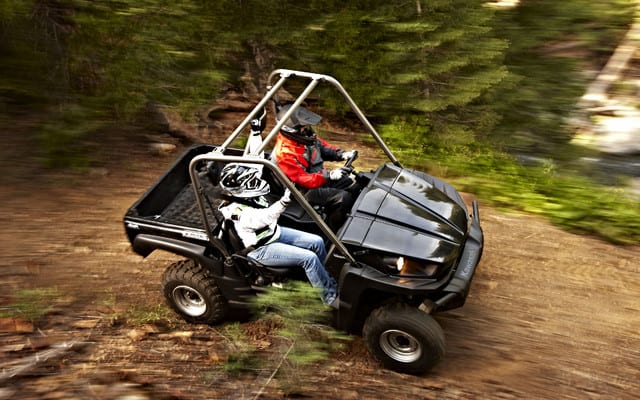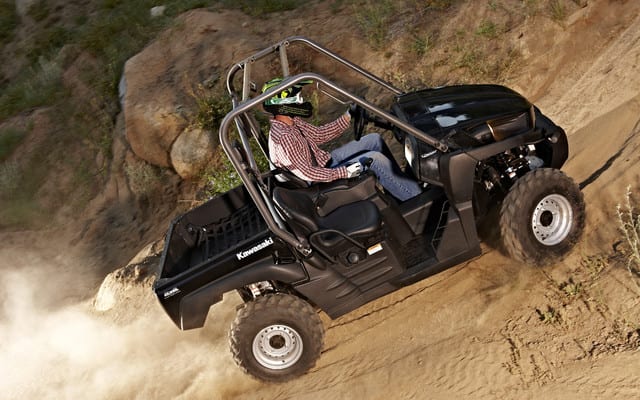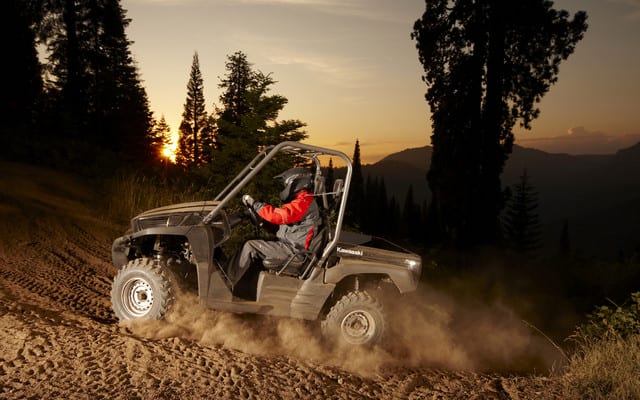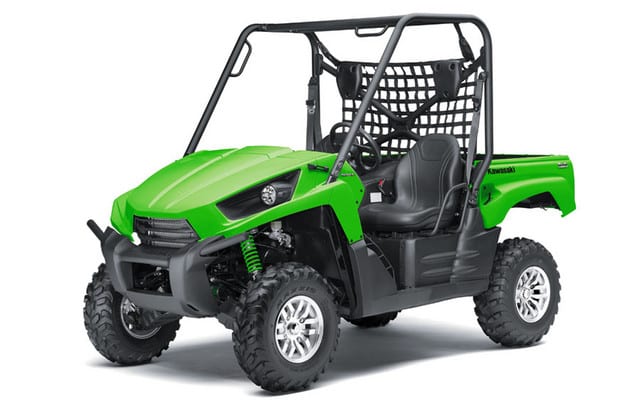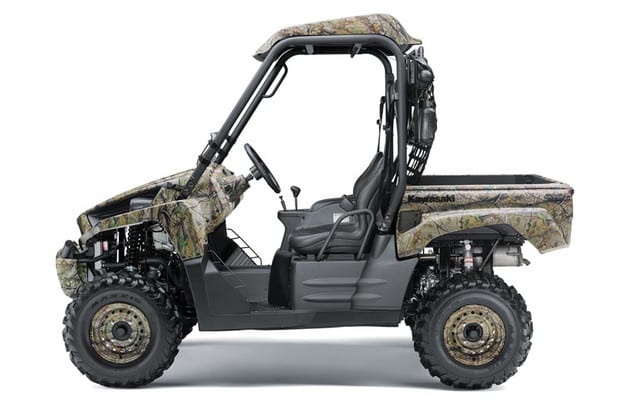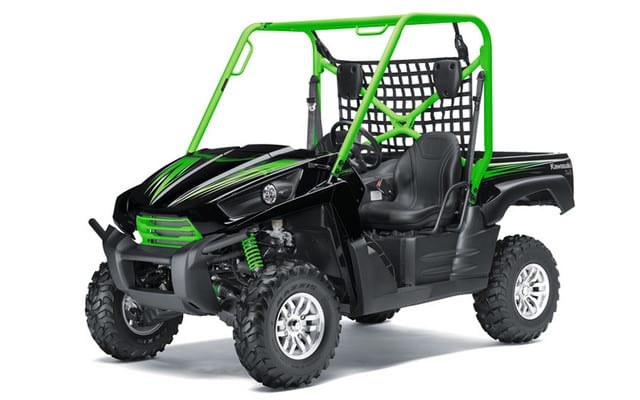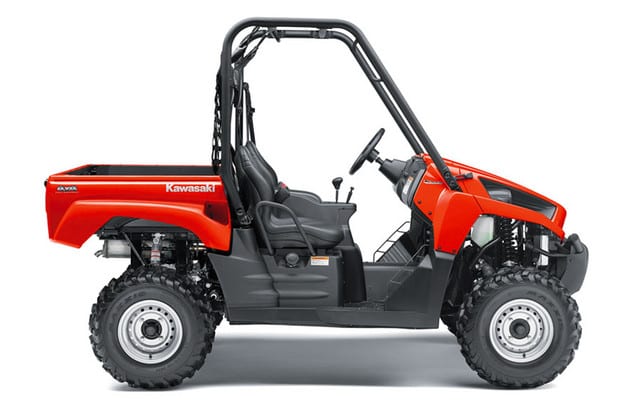The change is as surprising as it is radical. To differ from the bodywork that was certainly partly responsible for the great success of the Teryx RUV, is quite a bold move for Kawasaki. I, for one, took time to try it and I like it more than the old look and it hasn’t sunk in yet. I don’t know, maybe it’s like when you listen to your favorite band playing a new song. You need to listen to it a few times, before you start liking it, and then you eventually love it as much as all the others. Truth is, the old Teryx was tough to improve on in the looks department, for sure, and I would have been thoroughly satisfied with just a few tweaks here and there.
At least, this major change to the bodywork doesn’t only serve to make the ride look better, but also makes it more practical. The new hinged, forward-tilting front hood, which is surely the most differently designed part of the ride compared to the 2009, allows quicker access to the radiator and front suspension components, for easier suspension tuning and maintenance. Of course, a new front grill design compliments the new styling. Also new is the larger-diameter radiator fan, going from 211 mm to 282 mm, increasing cooling capacity and a coolant reservoir relocated under the hood, for easy access. The Teryx still features a Roll-Over Protective Structure (ROPS), which is now black (on the red model), or gray (on the black model). The 2009 had a really cool- looking red cage matching the red body. Luckily, the even cooler green one is still available on the special edition.
Propelling it forward is the same 749cc V-Twin that has a good reputation for reliability. Fuel injection was added to this mill in 2009 and this important feature has of course, been carried into 2010. This means a consistent feed of a perfect air/fuel mixture, despite different temperatures and altitudes. The engine has four valves per cylinder and single overhead cams drive the valves to produce very usable power. Power sliding on flat gravel roads is certainly possible on the Teryx, but not recommended, as it takes quite a bit of convincing in the form of aggressive steering. It’s just no power drifting Polaris RZR-S, and in that sense, it can be tricky to keep on all four, if you try and force it into a slide too much. Momentum is quickly gained out of turns, partly due to the fact that it has the biggest tires you can find in this class. Slow and rough sections are a breeze to go th rough, thanks to these same 26” tires mounted on 12” rims, which greatly contribute to its excellent rough road handling, tight trail agility and talent at overcoming large obstacles more easily than usual.
Steep climbs, tricky descents were no match for this vehicle’s conquering ability. The smoothness of the engine and CVT combo, with instant acceleration available at any rpm, surely helps take away some of the jerkiness, while rock climbing. In addition, a failsafe system automatically retards ignition timing and warns the rider via a belt warning lamp, should the engine operate at high rpm for more than 2 seconds, while the rear wheels remain motionless (i.e. rear wheels are immobilized and the belt is slipping). The system uses input from a gear sensor (not in neutral), vehicle speed (measured from the rear wheel), TPS (Throttle position sensor) and engine speed.
It is also important to mention that despite not having any power steering unit, steering is very light and easy on the Teryx. It does get harder in 4WD, but not much at all compared to several other ROVs. In addition, the 4WD and diff-lock controls are quickly accessible at the drop of your hand to its natural position. It is also very stable in turns for a machine of such small size in width. The Teryx is compact enough to fit in the bed of most full-size pickup trucks.
Despite the fact that this odd but cool and rougher-looking ride looks very different from the 2009 model, it stays basically unchanged, otherwise. The same plush, spacey seating and well-built and placed controls can be enjoyed in this Teryx too. The three-point style seatbelts adjust to any size rider, but for my tall size, I would have wished the upper anchorage point to be a bit higher or simply be adjustable as is the case in many cars now. The deep foot wells assist in keeping legs inside the vehicle as well as keeping trail obstacles out. It does have a new digital dash pod displaying: a digital speedometer, digital fuel gauge, odometer, hour meter, 4WD indicator, parking indicator, water temperature warning indicator, fuel injection warning indicator, clock, dual trip meters, CVT belt warning light, neutral indicator light, reverse indicator light and finally an oil pressure warning light.
I really like Kawasaki’s tagline, “Let the good times roll”, recognized worldwide. That’s exactly what I set out to do when I first strapped in securely with my carlike three point seat belt in my new found friend; a Kawasaki Teryx 750 FI 4×4 Sport. Now enjoying this ride’s well balanced mix of power and agility, the only thing that could succeed at stopping me, while at the controls of the 2009 version of this successful Side by Side offering from Kawasaki, would be a breathtaking scenery surrounding me, and there I was near Phoenix Arizona, in December of 2008, and that was one of the rare times I drove around with something else to watch than the ground a few feet in front of me. But to tell you the truth, at the logical speed I was going, I needed not worry about rocks and other small size obstacles in my path. I had noticed early on in the ride that it shined at clearing anything and everything rough to be found, in that magnificent part of the world, anyway.
Even in water way up over the floorboards, the Teryx just won’t quit. The CVT intake and exhaust are located high to keep everything breathing in clean air and leaving water out. Also completely unaffected by water or dirt, mud or rocks; the sealed internal wet brake is one of the most reliable and maintenance-free braking system you can find. Hydraulic disc brakes also take good care of business at the front. Incredibly fun to explore, the Arizona scenery was always deterring my attention. So I decided to ride a little harder to targeted points, a good distance ahead in the trail. Perfectly visible in its entirety from the mountain ridge I was rolling on; the trail snaked through the vast land and disappeared far in the distance. My next target was far away, but very easy to spot, a huge cactus stood alone next to the curving trail in plain view from any point halfway up the next hill side. Getting there meant rolling down fun wide and dry trails, slowly descending tricky rock formations and end up at the bottom into a dried out river. The Teryx behaved like a champ all the way down, I only touched the brakes a few times thanks to the nice amount of engine braking, without ever causing any excessive wheel lock.
Blasting along this dry river bed, pedal to the floor, with this oh so beautiful 2009 Teryx (snif snif), I felt like someone had drawn this wide snaky rock road especially for this vehicle. I never reached my designated target, turning back instead and flooring it again for what was one of the most fun times I ever had on any off-road vehicle. As the sun was going down, everything switched into a sort of romantic calm. Beautiful rocky peaks protruding majestically straight up from the earth, randomly placed cactus here and there, I remember the experience quite vividly, and my time riding was just as enjoyable as those many times when I stopped. Just walking away from my ride, heart still pumping, turning around, and contemplating the majestic view with my newly found beautiful green monster included in the frame. It was truly, a sight for sore eyes. Oh well, I guess I would need to go back there with this new 2010 version, and try and see if that helps.
Kawasaki, as we do, encourages RUV drivers to drive responsibly and to respect the environment.
What’s new?
- Completely revised bodywork design.
- Slightly increased flyweight mass offers a slight increase in torque feel.
- Larger-diameter radiator fan.
- Revised front grill design to compliment the new styling.
- Coolant reservoir relocated under the hood, for easy access.
- Hinged, forward-tilting front hood.
- Ignition cut-out feature protects the brake system by preventing riding with the parking brake on.
For more information on the above mentioned models, please visit the Kawasaki Website
More from Kawasaki on ATV Trail Rider :
Kawasaki ATV Models – Kawasaki UTV Models – Kawasaki ATV Reviews – Kawasaki UTV Reviews


